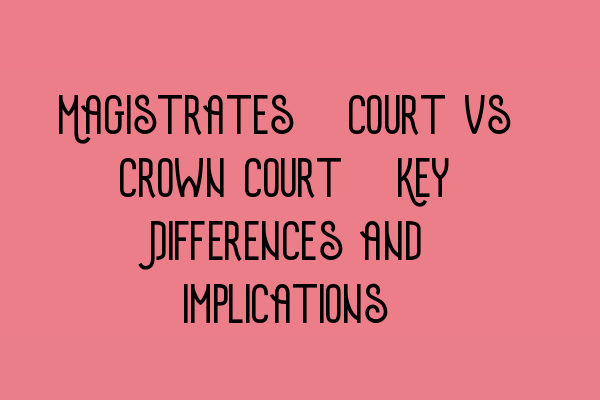Magistrates’ Court vs Crown Court: Key Differences and Implications
Welcome to the latest blog post from SQE Criminal Law & Practice Law UK. In this article, we will discuss the key differences and implications between Magistrates’ Court and Crown Court. Understanding these differences is essential for anyone involved in criminal law practice.
Magistrates’ Court
Magistrates’ Court is the lower court in the criminal justice system. It deals with less serious criminal offenses. The court is presided over by magistrates, who are trained volunteers without legal qualifications. They are assisted by legal advisors. Magistrates’ Court primarily handles preliminary hearings and less serious cases, such as minor assaults, theft, and road traffic offenses.
One of the key features of Magistrates’ Court is the summary trial process. Summary trials are speedy trials where the magistrates decide both guilt and punishment. There is no provision for a jury trial in the Magistrates’ Court. If the defendant pleads not guilty or if the offense is more serious, the case may be transferred to the Crown Court for a trial.
It’s important to note that Magistrates’ Court has limited sentencing powers. The maximum punishment that can be imposed by the magistrates is typically six months in prison for a single offense, or a fine. For more serious offenses, the magistrates may send the case to the Crown Court for sentencing.
Crown Court
Crown Court is the higher court in the criminal justice system. It deals with more serious criminal offenses, such as murder, rape, and large-scale fraud. The court is presided over by a judge and a jury, consisting of twelve members of the public. Crown Court trials are typically longer and more complex compared to trials in Magistrates’ Court.
One of the key differences between Magistrates’ Court and Crown Court is the power to impose more severe punishments. Crown Court has extensive sentencing powers, including the ability to impose longer prison sentences and more substantial fines. In some cases, Crown Court may also impose life sentences.
Crown Court trials provide defendants with the opportunity for a trial by jury. This means that the jury decides both guilt and punishment, based on the evidence presented in court. In complex cases, such as fraud trials, the involvement of a jury ensures a fair and balanced verdict.
Implications
Understanding the key differences between Magistrates’ Court and Crown Court is crucial for criminal law practitioners. It allows them to assess the nature and seriousness of the offense, determine the appropriate court to proceed with the case, and provide the best possible legal representation for their clients.
If you’re preparing for the SQE 1 exam, make sure to check out our SQE 1 Practice Exam Questions to test your knowledge and improve your understanding of criminal law.
For SQE 1 and SQE 2 preparation courses, visit our website to explore the wide range of resources and expert guidance available, including our SQE 1 Practice Mocks FLK1 FLK2 and SQE 2 Preparation Courses.
Stay up to date with the latest SRA SQE Exam Dates to plan your study schedule effectively and ensure successful exam performance.
We hope this article has provided you with valuable insights into the key differences and implications between Magistrates’ Court and Crown Court. For more informative content, stay tuned to our blog.
